 Image search results - "emperor" Image search results - "emperor" |

Statue of Emperor Keitai in Asuwayama Park 継体天皇像The 26th Emperor of Japan is said to have hailed from Echizen Province.
|
|

Dec. 23, 2004 at 8:30 am: Across the street from the Imperial Palace. Dec. 23 and Jan. 2 are the only two days when the general public is allowed to enter the palace to greet the Emperor and his family.A visit to the Imperial Palace by the general public is called "ippan sanga" in Japanese (一般参賀).
On the Emperor's birthday, the Imperial Palace can be entered only at certain locations. You have to find out where they are and stand in line there. Just go near the Imperial Palace and ask a policeman where you can stand in line. You otherwise cannot enter the grounds. The huge, graveled plaza where you can see Nijubashi Bridge is closed off by police.
While standing in line here, we received free paper Japanese flags.
|
|
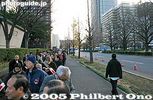
Line behind
|
|

8:37 am: We crossed the street to enter Imperial Palace grounds
|
|
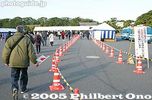
Bag checkpoint ahead. They inspected all our bags. Note that they do not allow any drinks (not even water) to be taken into the palace. You will have to dump it in the trash can they provide.
|
|
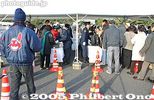
8:40 am: Bag check
|
|
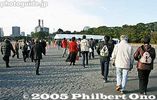
Body inspection up ahead. They frisked the body and also used a metal detector as well. I had to explain that the hump in my pants pocket was a wallet and cell phone. He believed me since I have an honest-looking face.
|
|

8:43 am: Passed body check and walking to waiting line. After seeing these coned lanes, I was glad that I went early. I don't know if all these lanes were later filled with people, but probably yes.
|
|

Lining up in line 1
|
|

Approaching the entrance near Nijubashi Bridge
|
|

9:20 am: Long line behind. If it's a sunny day, it's sunburn time. We waited here for over 30 min.
|
|

Merging with another line up ahead
|
|
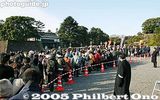
9:28 am: Finally walking toward Nijubashi Bridge. There were a lot of men in trench coats gazing at the crowd.
|
|

Getting closer to the bridge
|
|

Nijubashi Bridge straight ahead!
|
|

9:31 am: Crossing the famous Nijubashi Bridge. It turned out to be a completely modern bridge, no sqeaking or anything. 二重橋
|
|
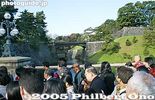
Right view from Nijubashi Bridge. In the distance, you can see another parallel bridge which leads directly into the inner grounds of the palace. We will cross that bridge too. There is also the castle-like structure called the Fushimi Turret.
|
|

Left view from Nijubashi Bridge. Everyone knows what the Nijubashi Bridge looks like from outside. Finally, we see what it looks like from the bridge. 二重橋
|
|
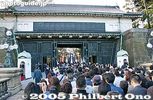
On Nijubashi Bridge heading for the Seimon Gate. 正門
|
|

Main gate
|
|
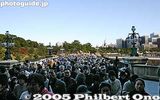
9:33 am: Behind us on Nijubashi Bridge. 二重橋
|
|

Walking toward the second bridge
|
|
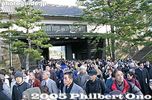
Out of the main gate. Everything was very orderly, no pushing nor shoving.
|
|

9:35 am: Walking toward the second bridge. We walked up a slight slope to reach the second, parallel bridge. The Fushimi Turret is in the background.
|
|

Fushimi Turret. This view of the turret can only be had when you cross the bridge. I never knew what it really looked like until this day. 伏見櫓
|
|
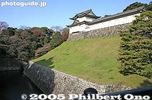
Fushimi Turret. This view of the turret can only be had when you cross the bridge. I never knew what it really looked like until this day. 伏見櫓
|
|

9:38 am: Crossing the second bridge. The first Nijubashi Bridge, which we crossed first, is in the distance. Nijubashi means double bridge. 二重橋
|
|
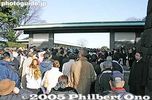
Nakamon Gate to Imperial Palace 中門
|
|

9:40 am: Inside the Imperial Palace. This is called the Kyudentotei. It is a large plaza in front of the palace.
|
|

Kyuden Totei plaza
|
|
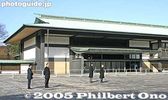
Entrance for state guests. This is where heads of state and other royalty enter this building.
|
|

Filling up the plaza
|
|

The center is filled up first. The center is in front of the balcony where the Imperial family will appear. Thus, the earlier you go, the better chance of you standing in front of the balcony.
|
|
|
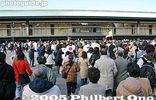
Good location
|
|

9:43 am: Almost front and center
|
|

People behind fill up the rest of the plaza
|
|

Behind us. At the very rear below the trees, there is a slightly elevated platform where the news media can take photos. You can see many tripods set up. That's how they are able to photograph the Emperor with the flags waving well below the balcony.
|
|

Filled on our right
|
|

9:57 am: Filled on our left. The entire place was full by 10 am. Quite a few foreigners were present as well. Rightists with large flags were also there.
|
|
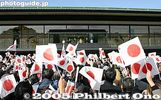
10:20 am: The Emperor and Empress appear right on time on his birthday. As soon as they appeared, people waved paper flags and cheered "banzai!" Also see the video at YouTube.It was an amazing spectacle. I always saw it on TV, but this was the first time I saw it in person. I wish I went when Emperor Hirohito was still living.
From left to right is Princess Nori, the Crown Prince, the Emperor, the Empress, and Prince and Princess Akishino. Crown Princess Masako did not appear due to illness.
I also once used this shot for the cover photo on my home page.
|
|

10:22 am: The Emperor speaks. When the Emperor spoke, the crowd immediately fell silent and all the flags stopped waving. He spoke for only about a minute, thanking us for celebrating his birthday and mentioning this past year's numerous natural disasAfter he finished, everyone waved the flags again and cheered.
|
|
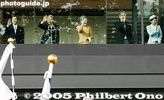
10:23 am: They wave to the crowd again. From left to right is the Crown Prince, the Emperor, the Empress, and Prince and Princess Akishino.It was very difficult to get a good shot of them since so many flags were in the way. I had to hold the camera overhead above the flags and shoot almost blindly with my telephoto lens. Luckily, I managed to get a few decent closeup shots.
|
|
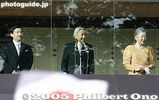
The Crown Prince, the Emperor, and the Empress on the Emperor's Birthday. They were on the balcony for a whole THREE minutes. I thought they would stay there for at least 10 min. Barely had time to mount my telephoto lens.
|
|

10:24 am: After 3 min. on the balcony, they were gone. We waited almost 2 hours for a 3-min. appearance. But I think it's something you should do at least once while in Japan.
|
|

Even Santa Claus came (from Finland??). I'm told that they might be Finns. (Santa is from Finland.)
|
|

10:25 am: Clearing out the crowd. We were promptly herded to the exit to make room for the next horde of people waiting to see the Emperor who appeared two more times that day.
|
|

Japan fans. The sign says, "Downward slope ahead, walk slowly." It's only about 10:30 am, so it's a good time to walk around the Imperial Palace and the East Gardens. Although no flowers are in bloom, you might see autumn leaves.For more info about the Imperial Family and visiting the palace, see the Imperial Household Agency's Web site.
|
|

Shishinden Hall, the most important building at Kyoto Imperial Palace. It faces a plaza of grooved, white gravel. 紫宸殿
|
|

Even the uneme court waitress looks like a princess.
|
|
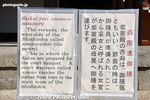
About the omonayadori.
|
|

Another major palace building is this Seiryoden, the emperor's residence from the late 8th century to 11th century. This is a reconstruction built in 1790 on a smaller scale, but close to the style of the original building. 清涼殿
|
|

We could clearly see inside the Seiryoden. 清涼殿
|
|

The emperor's throne canopy inside the Seiryoden.
|
|

About the Seiryoden.
|
|

Seiryoden 清涼殿
|
|

Roof renovations
|
|
|
|

Kogosho was a ceremonial hall for Coming-of-Age ceremonies for Imperial princes and when the emperor met with the shogun and daimyos. This building was reconstructed in 1958. 小御所
|
|

The Kogosho had a large Zejo hanging tapestry of a pine tree.
|
|

Zejo hanging tapestry inside the Kogosho.
|
|
|
|
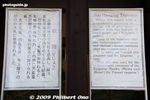
About the Zejo hanging tapestry.
|
|

Keyakibashi Bridge in Oike-niwa Garden.
|
|

The Kogosho faced this garden called Oike-niwa. 御池庭
|
|

Connected to the Kogosho was the Ogakumonjo. 御学問所
|
|

The Ogakumonjo was the emperor's study. It was also used for monthly poetry parties and when the emperor received regents, Imperial advisors, government ministers, Imperial princes, etc.
|
|

The Ogakumonjo had a display of palace guards and official attendants.
|
|
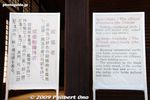
About the palace guards and official attendants.
|
|

Palace guard
|
|
|
|
|

Painting inside the Ogakumonjo.
|
|

Gonaitei Garden was the emperor's private garden. 御内庭
|
|

Now we came to the palace's largest structure called Otsunegoten. This was the actual residence of the emperor. Emperor Meiji lived here until he moved to Tokyo.
|
|

Rooms of the Otsunegoten had painted walls and sliding doors. 御常御殿
|
|
|

The Otsunegoten has 15 rooms. 常御殿
|
|

About the paintings in a room of the Otsunegoten.
|
|
|
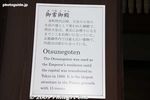
About the Otsunegoten in English.
|
|

Otsunegoten. The connected building beyond is the Omima.
|
|
|
|

Otsunegoten
|
|
|
|
|
|
|
|

The normal palace tour would end here, but for Emperor Akihito's 20th anniversary, we were allowed to proceed to the northern palace quarters. 清所門
|
|

Entering the northern palace quarters.
|
|

A nice wooded path to the northern palace quarters of Kyoto Imperial Palace.
|
|

Going through another gate to the northern quarters.
|
|

The northern palace quarters is dominated by this Kogogu Tsunegoten, the former residence of the empress. So, did the emperor and empress live separately? 皇后宮常御殿
|
|

The Kogogu Tsunegoten has 13 rooms. The building was constructed at the end of the 16th century.
|
|

Painted fusuma sliding doors in the Kogogu Tsunegoten.
|
|
|

Genkimon Gate 玄輝門
|
|

Sakuheimon Gate, the main gate to Kogo Otsunegoten. Ornate but it was too narrow for us to get a good front view. 朔平門
|
|

Sakuheimon Gate 朔平門
|
|

Higyosha (also called Fuji-tsubo because of the wisteria in the inner courtyard) was the residence of the court ladies. It has a Heian-kyo style architecture. 飛香舎 藤壺
|
|

Higyosha
|
|

About the Higyosha.
|
|

Connected to the Higyosha is the Wakamiya/Himemiya Goten palace where Imperial children lived. Emperor Meiji lived here during childhood.
|
|

Rooms inside the Wakamiya/Himemiya Goten. The building had two sections of four rooms each. One section was for child princes (wakamiya) and the other was for child princesses (Himemiya).
|
|

Wakamiya/Himemiya Goten
|
|

Wakamiya/Himemiya Goten. Normal kids would rip up the paper sliding doors.
|
|
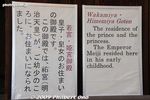
About the Wakamiya/Himemiya Goten.
|
|

Behind the Kogogu Tsunegoten was a display of wedding attire of the emperor and empress.
|
|

Roof of Kogogu Tsunegoten.
|
|

Wedding attire of the empress wearing juni-hitoe kimono, and the emperor wearing sokutai.
|
|

Juni-hitoe kimono worn by the empress.
|
|
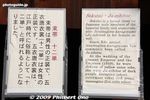
About the juni-hitoe kimono and sokutai.
|
|

Displayed behind the wedding attire was this Nikai-zushi cabinet.
|
|
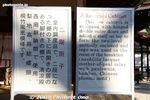
About the Nikai-zushi cabinet.
|
|
|

Seishomon Gate was the exit. This is the gate normally used by the public. In the old days, it was the palace's "kitchen door" since it was used as a service entrance. It was also used by Imperial children. 清所門
|
|

Sweets sold for the 20th anniversary of the enthronement.
|
|

Scale model of the Kyoto Gyoen National Garden.
|
|

Model of Kyoto Imperial Palace.
|
|
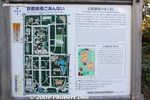
Map and about the Kyoto Gyoen National Garden.
|
|

Built in 1940, Omi Jingu Shrine is dedicated to Emperor Tenji who moved the capital to Otsu in 667 at the location of this shrine. Otsu was therefore once the capital of Japan. MAP
|
|

Path to shrine. Omi Shrine is a short walk from Omi Jingu-mae Station on the Keihan Ishiyama-Sakamoto Line.
|
|

Steps to Rōmon Gate, the shrine's most outstanding structure. (楼門)
|
|

Omi Jingu Shrine's Rōmon Gate (楼門)
|
|

Omi Jingu Shrine's Rōmon Gate (楼門)
|
|

Poetry
|
|

Gift shop and clock museum in background. 時計博物館
|
|
|

Sotokairo corridor (外廻廊), Jinpu-Juyosho shop selling souvenirs (神符授与所), and Rōmon Gate (楼門)
|
|

Sun dial. Another one in the background as well. Hidokei I (日時計1: Sundial I)
|
|

Gehaiden Hall (Outer Haiden 外拝殿)
|
|

Inner side of Omi Jingu Shrine's Rōmon Gate (楼門).
|
|

Naihaiden Hall (Inner Haiden 内拝殿)
|
|

Naihaiden Hall
|
|

Corridor
|
|

Used New Year's decorations
|
|

Karuta Festival poster
|
|
|
|
|

The Shamusho Shrine office I (社務所I) serves as the Karuta Matsuri tournament venue.
|
|
|

Karuta Festival. The narrator (standing) recites one of the poems and the contestants must search for and claim the card written with the poem.
|
|

Karuta cards with verses from famous poems
|
|
|
|
|
|